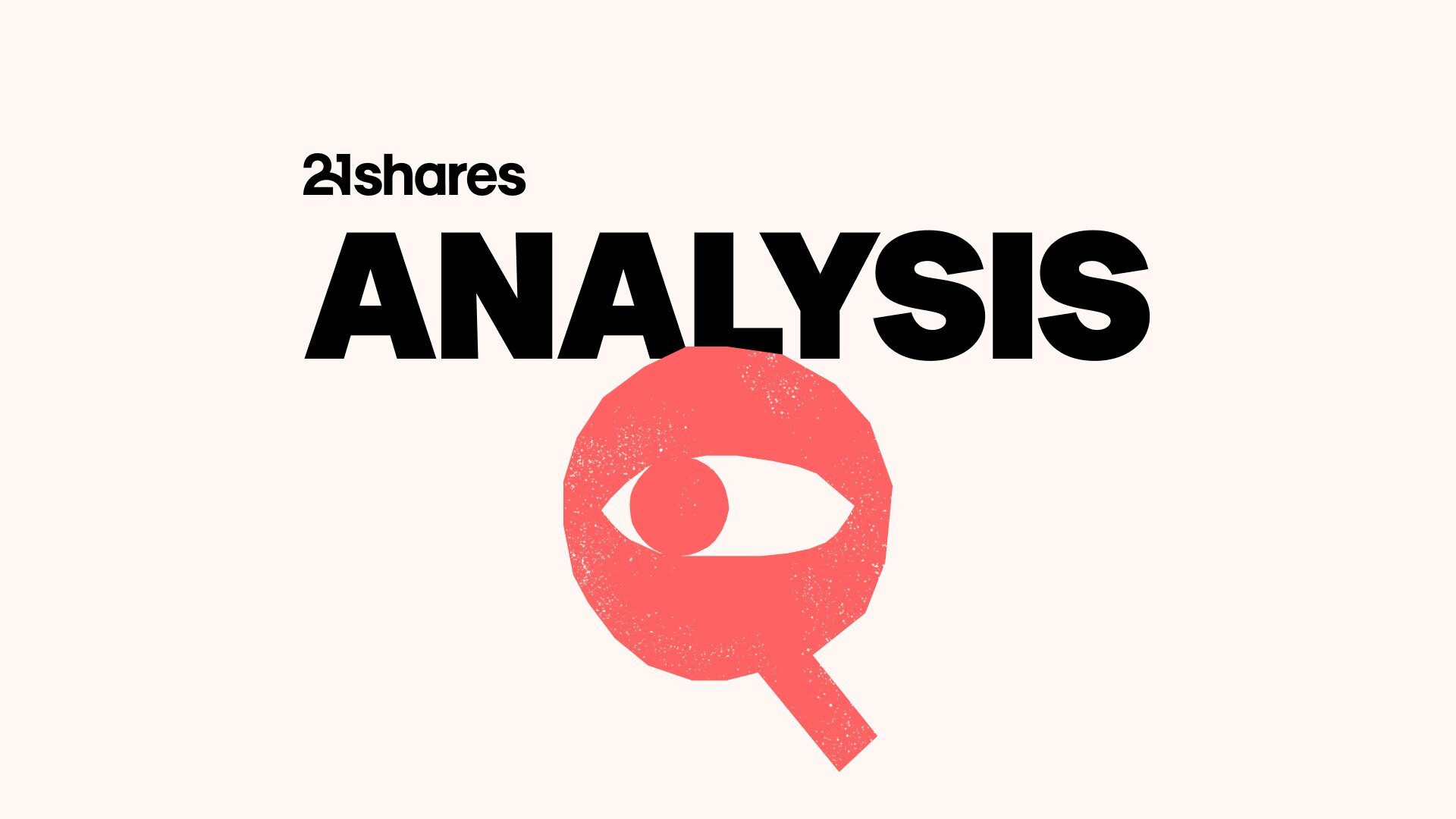Ethereum 101



What is Ethereum?
Ethereum, the second-largest cryptocurrency by market capitalization, operates as a decentralized blockchain network powered by the ETH token. Unlike its big brother Bitcoin, Ethereum offers a distinct value proposition. While Bitcoin pioneered decentralized peer-to-peer digital payment system, Ethereum introduced the concept of “programmable money”, revolutionizing blockchain technology. At the core of Ethereum’s innovation are “smart contracts”, computer programs executed on the blockchain. These contracts enable developers to code and deploy decentralized financial instruments or applications with unprecedented flexibility.
Ethereum’s programmable nature extends its utility far beyond simple transactions. Users can engage in various activities, such as earning interest on holdings, playing games, and accessing decentralized social media platforms. This versatility has earned Ethereum the title of a “Next-Gen App Store” and positioned it as a catalyst for the next phase of internet development.
The Start of Ethereum - A New Age for Digital Assets
In 2014, Ethereum raised $18 million in BTC during its initial crowdfunding campaign through an initial coin offering (ICO) similar to an IPO in traditional finance. This marked a significant milestone in Ethereum’s journey and set a precedent for future funding practices for blockchain based projects.
Ethereum officially launched in 2015, founded by Vitalik Buterin in order to expand the capabilities of blockchain technology. Ethereum sought to build upon Bitcoin’s success by introducing the revolutionary concept of smart contracts. These self-executing contracts enable developers to create decentralized applications (dApps) and unlock a world of possibilities beyond simple transactions.
Ethereum’s development is characterized by a relentless pursuit of innovation. The introduction of Ethereum Improvement Proposals (EIPs) implements a community-driven upgrade framework which Ethereum uses to undergo numerous iterations and improvements to enhance scalability, security and functionality. For example, one of Ethereum’s most anticipated milestones was the launch of Ethereum 2.0, which transitioned the network from a proof-of-work to a proof-of-stake consensus mechanism, addressing scalability concerns and laying foundations for a more sustainable and efficient network.
Nowadays, Ethereum stands as a cornerstone of the blockchain ecosystem, powering an array of dApps, decentralized finance (DeFi) protocols, and NFTs. With a vibrant developer community, Ethereum continues to push boundaries of what is possible in the digital asset space.
How Does Ethereum Work?
Much like Bitcoin, Ethereum is a peer-to-peer network where transactions are recorded in a public, decentralized ledger (which can be monitored via https://etherscan.io/). What’s different about Ethereum is that it launched out of Bitcoin’s initial limitation as a simple settlement layer where people send and receive coins. From the start, Ethereum positioned itself as the infrastructure for building applications similar to websites or mobile applications like Robinhood, for example, on top of a fully decentralized internet.
Before September 15, 2022, the Ethereum network was following Bitcoin’s consensus mechanism, the Proof-of-Work. That means that Ethereum miners used computational power as fuel for validating the security of its ecosystem; miners had to submit the solution to a computationally expensive puzzle to be able to propose a block of transactions. By adopting a Proof-of-Stake consensus mechanism, in the event called “The Merge,” Ethereum transitioned into a more sustainable model that replaced “miners” and the reliance on “computational power” with “validators” incentivized by “staked ETH.” This mechanism hits two birds with one stone: making Ethereum more environmentally conscious, reducing its energy consumption by approximately 99.95%, and turning ETH into a capital asset. Additionally, it accompanies a 50% reduction in its annualized issuance post-merge.
What Is Staking?
Analogous to a security deposit, staking involves participants locking up a certain amount of ETH in a smart contract, known as a validator, to support the network and earn rewards. Validators are responsible for proposing and validating new blocks, and they receive incentives in the form of newly minted ETH and transaction fees for their participation. By staking ETH, validators contribute to network security and decentralization while earning rewards for their efforts.
Similar to what computational power is to Bitcoin miners, staking is the act of depositing 32 ETH to activate validator software. Validators, much like traffic controllers or checkpoints, are responsible for storing data, processing transactions, and adding new blocks to the blockchain. Moreover, Ethereum users are encouraged to directly deposit their ETH to validators to incentivize them to take on more blocks and, in turn, secure the network, thereby enabling users with small amounts of ETH to participate and earn rewards without needing to stake the full 32 ETH required to become individual validators. In return for their efforts, Ethereum users earn a yield proportional to their contribution, estimated to be 4-7% annually. In the upcoming sections, we’ll explore in more detail how individuals with modest capital can leverage alternative tools to actively participate in staking.
Lockup period: To prevent a bank run, validators must keep their tokens locked for a certain number of hours or days, determined by the network’s demand. The lockup period is highly variable, and it depends on how congested the network is and the amount of people that are trying to join the network. This can be monitored on Validator Queue.

Reward for securing the network: So far in 2024, there are around a million validators on Ethereum, which is a significant growth from just over 560K validators on the network last year. Rewards are divided into two categories: block rewards and transaction fees.
Block rewards: Pre-Merge, people wishing to mint coins received a fixed amount of ETH per block. It started with 5 ETH, then got reduced to 3 ETH per block in 2017, then 2 ETH in 2018 until the Merge in 2022. After Ethereum adopted the Proof-of-Stake (PoS) consensus mechanism, block rewards were no longer fixed or programmed like Bitcoin’s reward system. Now the block rewards come entirely from transaction fees, in addition to the returns received on the validators’ staked ETH, as shown in figure 3.
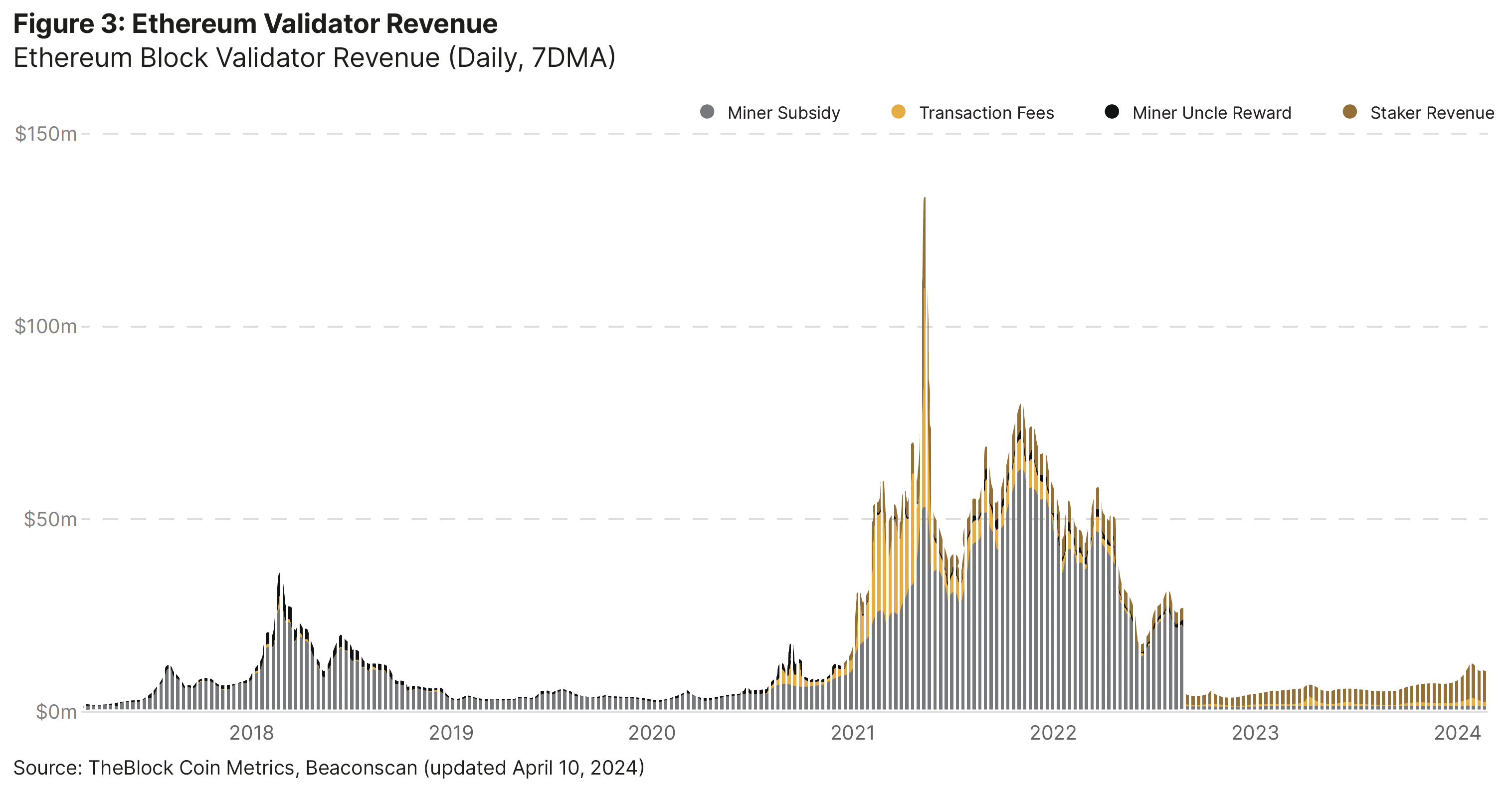
Transaction fees are paid to incentivize validators to carry out their transactions quickly. They’re divided into two parts: the “base fee” is burned to reduce ETH in the circulating supply, indirectly benefiting validators by potentially making their staked ETH more valuable due to its deflationary evolution. The second part is the “priority fee,” which is the compensation paid to validators who propose and add transactions to a block. The parameter determining the fees per transaction is an Ethereum unit called “gas,” measuring the amount of computational power needed and the amount of money a user is willing to pay to process a transaction. Additionally, users have the option to pay higher “gas fees” to prioritize their transactions.
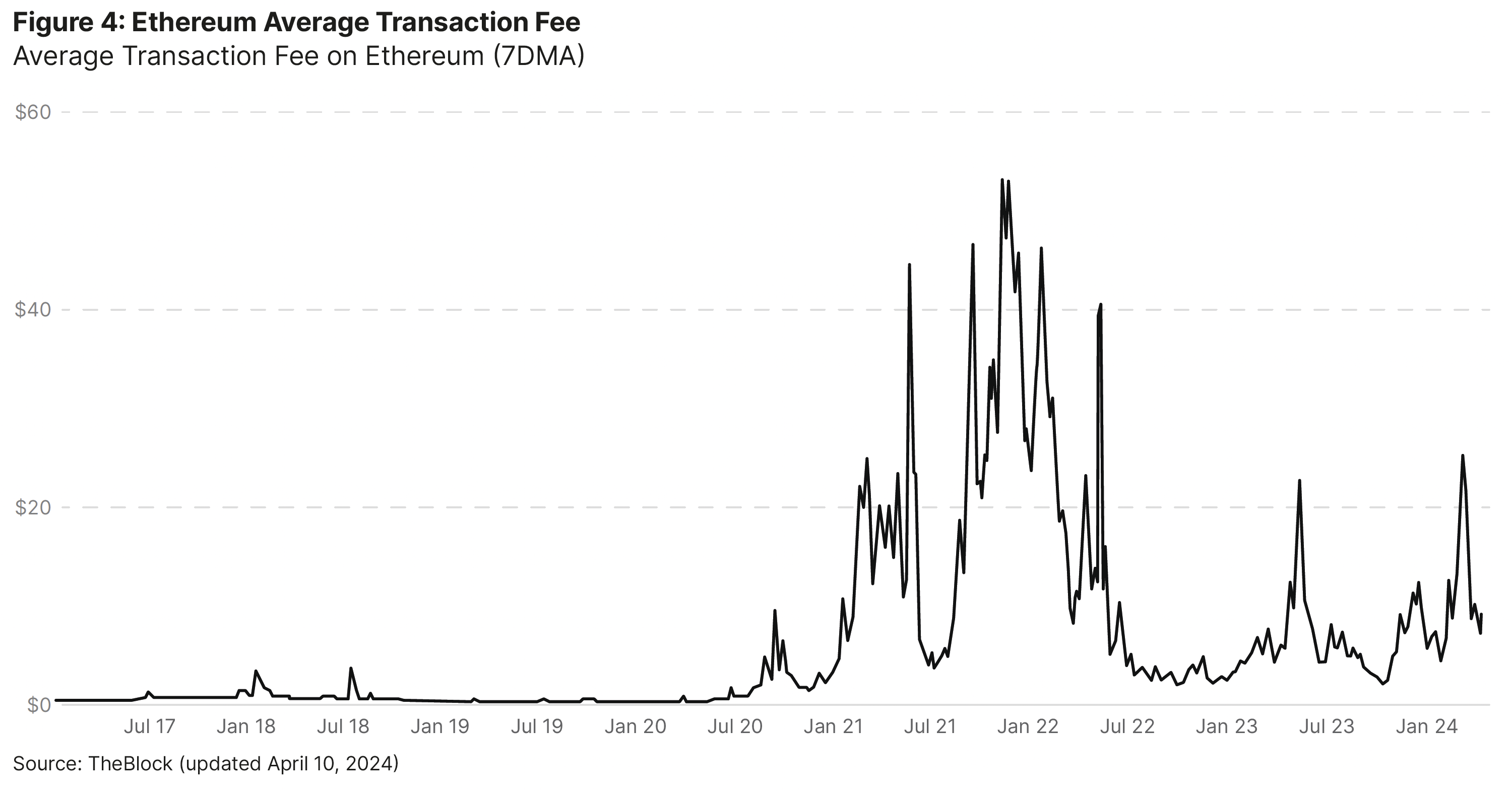
Penalty for malicious behavior: Slashing is a penalty system Ethereum has put in place to guarantee the network’s security by keeping the validators in check. There are two cases where a validator can’t risk getting slashed:
• Double Signing: A validator shouldn’t vote on two different blocks for the same height (position in the blockchain). If caught doing this, they get slashed.
• Inactivity: Validators are expected to be online and participate in the consensus process. If they are offline for too long, they risk being slashed.
Slashing helps maintain the integrity and security of the Ethereum network by penalizing misbehavior. It also incentivizes validators to act honestly and uphold the network’s rules. Thanks to blockchain technology’s transparency, slashing events can be tracked, as shown in figure 5.

Now that we have gone through the rules of the staking game let’s introduce you to the types of stakers available in Ethereum’s ecosystem.
• Solo stakers are individual users who have chosen to run a validator on Ethereum by staking a fixed deposit of 32 ETH. Solo stakers are considered the core of the network’s decentralization, democratizing staking space. Each solo staker’s rewards are directly proportional to their stake relative to the total staking amount. For instance, if a staker contributes 10% of the total staked ETH, they receive approximately 10% of the yield generated by the network. This democratic distribution of rewards incentivizes active participation while ensuring that all stakers are fairly rewarded for their contributions to Ethereum’s security and decentralization.
• Staking providers are solutions that allow more people with 32 ETH to stake and participate in the validating process without actually handling any of the technicalities.
• Staking pools improve the accessibility of the staking space by allowing people to stake in smaller amounts for a reward that is proportional to their investment.
New primitives like liquid staking, re-staking, and liquid re-staking have emerged and are being battle-tested but have gained a lot of traction since the Ethereum PoS conversion. Figure 6 breaks them down, while giving an example of decentralized apps (dApps), respective of each category.
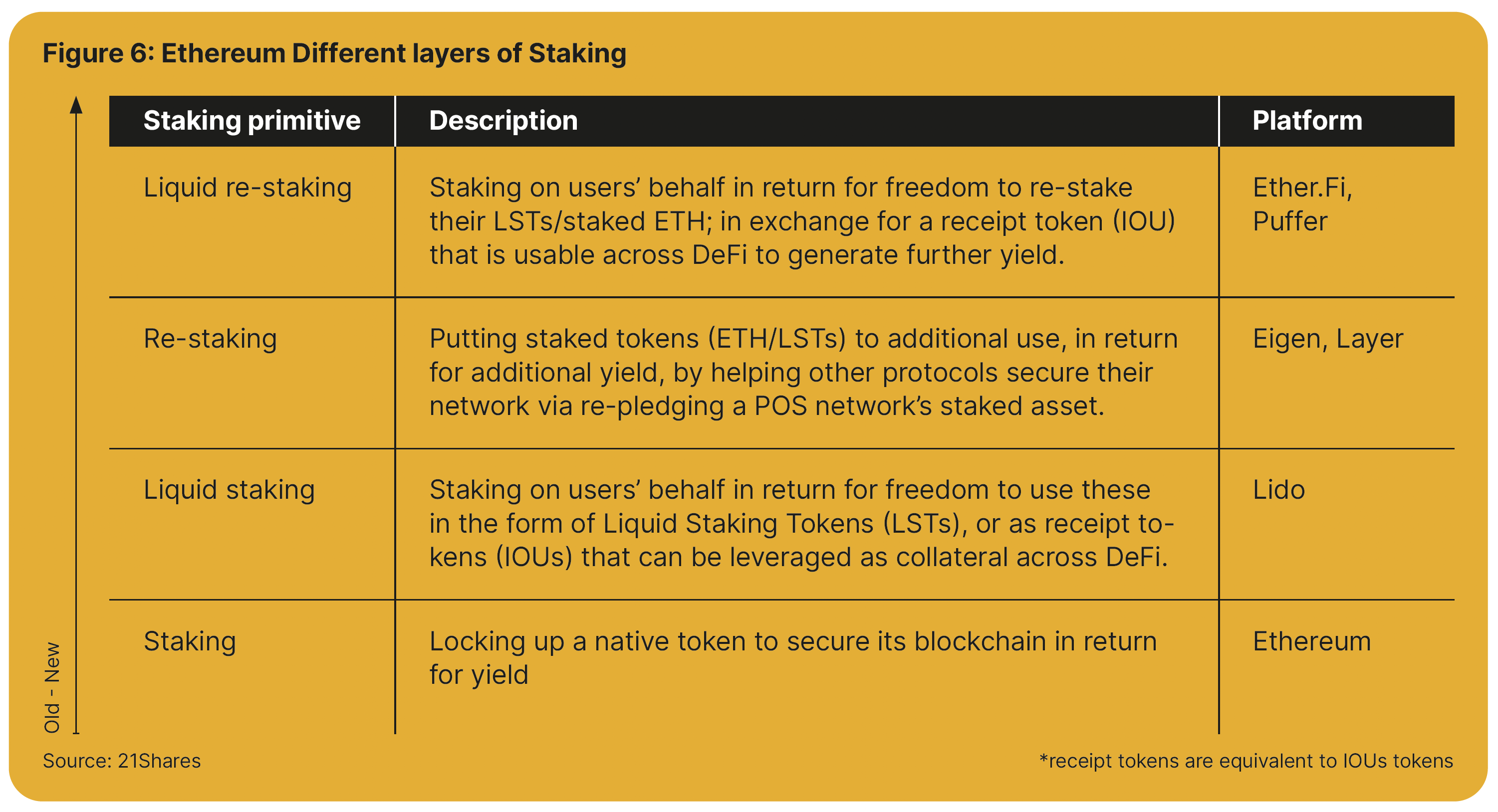
What Are dApps?
Decentralized applications, commonly referred to as dApps in the industry, operate like websites or mobile applications. Unlike the ones you usually visit on your browser or app store, these dApps operate on the Ethereum blockchain, meaning they enjoy the network’s transparency, security, and liquidity, making them resistant to censorship and downtime. These dApps perform a set of specific functions for their end users, and this relationship is governed by smart contracts. Unlike their traditional form, smart contracts are encoded with special powers to manage all their aspects, including payment and enforcement. It’s like having a contract with a built-in lawyer, cashier, and police officer. To engage with these dApps, users must acquire ETH to serve as a transactional currency, enabling them to access the applications and execute various actions. Moreover, thanks to the blockchain’s transparency, users can scrutinize a log of past activities within each application, including details such as withdrawals, deposits, user interaction frequency, and more. Although this level of transparency can offer assurances regarding the integrity of data, it does require careful consideration of privacy implications. All in all, the best way to think about smart-contracts is that they are self-executing agreements with predefined rules and conditions. Once they’re deployed on Ethereum, they autonomously facilitate and enforce transactions, eliminating the need for intermediaries and reducing the possibility of manipulation, while improving trust between parties, as the terms of the agreement are written directly into code and cannot be altered unilaterally.
Ethereum Supply
Ethereum’s supply dynamics are undergoing a significant transformation, driven by innovative mechanisms and protocol upgrades aimed at enhancing efficiency and sustainability. Historically, Ethereum operated on a similar issuance model to Bitcoin, with miners rewarded with newly minted Ether (ETH) for validating transactions through the PoW consensus mechanism. However, Ethereum’s journey towards becoming a deflationary asset began with the introduction of the London hard fork in August 2021, which introduced a number of EIPs.
At the heart of Ethereum’s deflationary shift is the implementation of the EIP-1559 upgrade, a pivotal milestone in Ethereum’s evolution. EIP-1559 overhauled Ethereum’s fee structure by introducing a base fee that adjusts dynamically based on network demand. This base fee is “burned”, or permanently removed from circulation, similar to a stock buy-back, for each transaction, while validators receive only the “tip”. The burning mechanism reduces the supply of ETH over time, making it deflationary. Additionally, EIP-1559 aims to optimize transaction fees and improve user experience by reducing fee volatility and network congestion.
Furthermore, Ethereum’s transition to Ethereum 2.0, “The Merge”, represented a significant step towards achieving sustainability and scalability. The merge replaced Ethereum’s energy-intensive PoW consensus mechanism with a more environmentally friendly PoS model, where validators secure the network and validate transactions based on the amount of ETH they hold and are willing to ‘stake’ as collateral. With Ethereum 2.0, Ethereum becomes like the foundation of a big digital marketplace. This foundation, called a settlement layer, helps people safely and quickly trade things, like digital assets - in an unbiased and unrestricted manner. Imagine it as the solid ground on which everyone can rely when they want to buy, sell, or do anything else on Ethereum, including the dApps built on top of it. This transition not only improves Ethereum’s scalability and security but also reinforces its deflationary nature thereby reducing the circulating supply, making it more scarce over time.
In summary, Ethereum’s supply dynamics have evolved significantly, driven by innovative upgrades such as EIP-1559 and Ethereum 2.0. The introduction of fee burning, coupled with the transition to a PoS consensus mechanism, has transformed Ethereum into a deflationary asset, evidenced by an annual inflation rate of -0.23% since “The Merge”.
Ethereum’s Product-Market Fit
Ethereum’s product market fit has evolved over time through several key developments. It stands as the leading smart contract platform within the digital asset ecosystem, by functioning as an expansive, borderless global computer, enabling developers to create and deploy applications without limitations. It embodies a vision of a non-restrictive app store, free from guardians who dictate which projects qualify to launch and which users can participate.
That said, Ethereum has evolved into a thriving hub for a diverse and engaged user community, alongside a rich ecosystem of applications. With an average daily user base exceeding 10 million, Ethereum hosts over 4,500 active applications, offering a wide array of services and functionalities to its users. DeFi has emerged as a key pillar of the Ethereum ecosystem, revolutionizing traditional financial models by providing highly accessible, liquid and transparent alternatives, built on ERC-20 tokens.
ERC-20 refers to a technical standard that defines how tokens interact with the Ethereum blockchain; these tokens function like digital dollar bills - meaning they are interchangeable and represent tradable assets. Platforms like Uniswap and Aave leverage these ERC-20, or fungible tokens, to facilitate a variety of financial services, mimicking traditional functions, featuring services that enable exchange, lending and borrowing of assets – all without intermediaries or limitations imposed by business hours. Ethereum’s DeFi sectors go beyond that as well to offer more functionalities like platforms offering savings accounts that pool investors’ crypto assets and invest them in a portfolio of yield-paying opportunities, automating the farming process to generate the highest yields possible.
It also includes platforms that allow users to engage in perpetual contract trading, similar to traditional futures contracts but devoid of expiry dates, affording traders the flexibility to maintain positions indefinitely. Perpetual protocols employ virtual automated market makers (vAMMs) to administer liquidity and collateral, obviating the necessity for physical market makers and mitigating impermanent loss risks. This architectural approach enables perpetual protocols to furnish high leverage, minimal slippage, and a trustless trading environment for users. Despite the growing number of digital assets available, Ethereum remains the DeFi leader in the space with over $49 billion locked in DeFi protocols, covering over 57% of the market share.
Ethereum’s smart contract functionality has also enabled projects that transform digital ownership through the form of Non-Fungible Tokens (NFTs). These are built on the ERC-721 token standard, which are unique, digital assets that cannot be replicated, unlike the ERC-20s used in DeFi, these tokens are more similar to trading cards or rare artwork. Each ERC-721 token carries a unique identifier, allowing for verifiable ownership and secure transfer on the Ethereum blockchain. Projects like OpenSea and Rarible have created marketplaces for these NFTs, specifically digital art, collectibles, and virtual gaming assets, empowering creators and collectors in this new ownership paradigm. Ethereum remained the leader here, with a market share of 72.3% and a trading volume of $8.5 billion in 2023.
Tokenization
Ethereum’s functionality is not limited to these two industry sectors, as multiple Web3 and real-world asset (RWA) tokenization initiatives build their applications on top of Ethereum. At its core, tokenisation involves the conversion of real-world assets—ranging from real estate and securities to art and intellectual property, into digital assets, or tokens, that are recorded on a blockchain. Each token represents a fraction of ownership in the asset, allowing for increased liquidity, fractional ownership opportunities, and streamlined transactions within a secure and transparent decentralized ledger system.
Tokenization represents a paradigm shift in the way assets are owned, traded, and managed. By digitizing assets and representing them as blockchain-based tokens, tokenization offers several compelling advantages, including enhanced liquidity, fractional ownership, and increased accessibility, democratizing investment opportunities.
One of the key drivers behind the rise of tokenisation is its ability to address inefficiencies such as: restricted market hours, and lack of transparency – inherent in traditional financial systems. By leveraging blockchain technology, tokenization can unlock previously untapped markets and asset classes, democratizing access to investment opportunities previously only available to institutional investors or high-net worth individuals, such as fine art.
In essence, Ethereum stands as a global computing powerhouse, boasting the largest DeFi ecosystem in the realm of digital assets. Distinguished by its unique deflationary mechanism, Ethereum steadily reduces its total supply by 0.32% since its inception, setting it apart in the crypto sphere. Beyond its pivotal role in DeFi, Ethereum has expanded its domain to embrace burgeoning sectors like gaming and tokenization. This expansion is underscored by its vast developer community, numbering over 7500 individuals dedicated to enriching the Ethereum ecosystem. Ultimately, Ethereum emerges as the foremost platform for smart-contract settlements, evidenced by the staggering $100B worth of ETH staked to fortify its security.

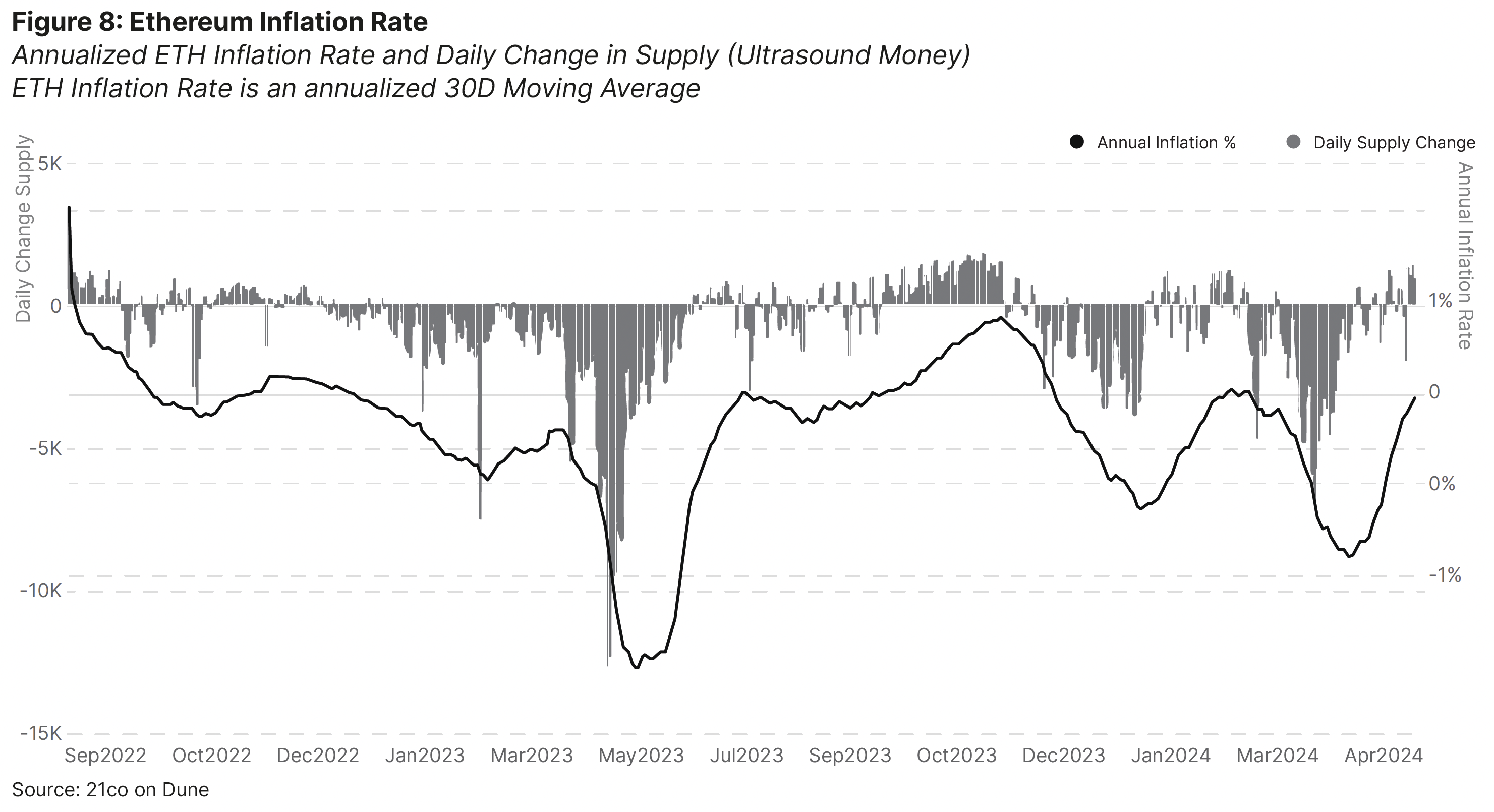
Ethereum & Beyond
That being said, the sheer number of use-cases on the protocol deliver an interesting problem of scalability to Ethereum: How can fees remain low for end-users and applications built on top, given the growing demand of the network? In order to address this vital issue, Ethereum must remain innovative and continue adopting proposals that enhance the user experience, such as the most recent “Dencun Upgrade” on March 13 2024, which reduced fees for scaling networks built on top of the pioneer blockchain, by up to 90%.
For context, Ethereum Layer 2 scaling solutions, abbreviated as L2s, are networks built on top of the Ethereum mainnet to manage transactions away from the primary blockchain. This strategy alleviates congestion, and reduces gas fees thereby enhancing Ethereum’s scalability and user accessibility. L2s operate by aggregating transactions from decentralized applications and subsequently ‘batching’ them before transmitting a condensed version onto the Ethereum mainnet. This methodology enables L2s to provide reduced fees, often up to 90% cheaper than those incurred on the primary chain, while increasing the amount of transactions that can be processed per second (growing from an average of 12 transactions per second processed on Ethereum to somewhere between 30-45 on L2s networks like Base and Arbitrum).
What’s worth remembering here is that L2s built on top of Ethereum actually help accrue value back to ETH. Given that the majority of L2s require users to pay transaction fees in ETH - in what is known as security costs - the growing transactions and activities occurring on Layer 2 solutions contribute significantly to the overall demand for Ethereum’s native token, ETH. This increased demand, coupled with the burning of ETH, can lead to a potential increase in the value of ETH as it becomes scarcer and more sought after within the Ethereum ecosystem. Therefore, while it might initially seem that scaling solutions diminish Ethereum’s transaction processing revenue, this evolving dynamic actually paves the way for a secondary revenue stream for the platform as Ethereum continues to serve as their final settlement platform.
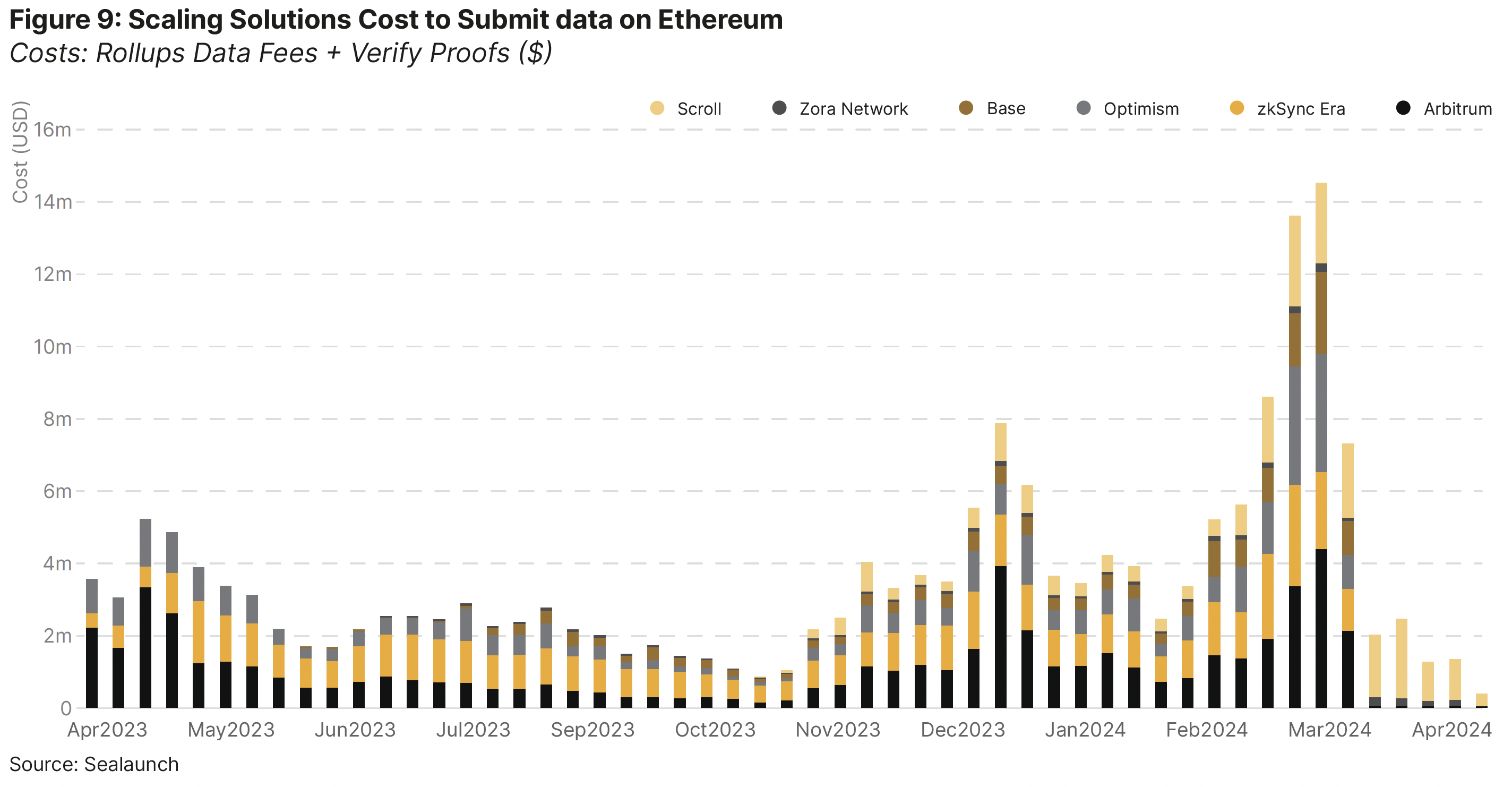
Disclaimer
The information included herein is the express opinion and experience of 21Shares and is provided for discussion purposes only. Past performance is not indicative of future results. Investors should consult with their own advisors for legal, tax, regulatory, financial, accounting, and other aspects relevant to the investment’s suitability and potential consequences.
This presentation is for informational and discussion purposes only and does not constitute an offer to sell or a solicitation of an offer to purchase any security. The information set forth herein does not claim to be complete and is subject to change. This presentation does not constitute a part of any document of any fund and should not be construed as an advertisement or marketing material for any fund.
Certain statements contained in this presentation are based on the expectations, estimates, projections, and opinions of 21Shares. Such statements involve known and unknown risks, uncertainties, and other factors, and reliance should not be placed thereon. This presentation contains “forward-looking statements,” the outcome of which may differ materially from those reflected or contemplated herein.
Certain economic, market, financial, and other information contained herein has been obtained from managers, service partners, and other parties besides 21Shares. While such sources are believed to be reliable, none of 21Shares or any of their respective affiliates or employees assumes any responsibility for the accuracy or completeness of the information contained in this presentation or to update any information contained herein.
Investing in crypto assets, including cryptocurrencies and crypto tokens, carries inherent risks. These assets are considered highly speculative due to their limited history and new technological nature. Future regulatory actions may impact the usability and tradability of crypto assets. The price of crypto assets can be influenced by a small number of holders and may decline in popularity or acceptance, affecting their value.
None of 21Shares nor any of its affiliates have made any representation or warranty, express or implied, with respect to the fairness, correctness, accuracy, reasonableness or completeness of any of the information contained herein (including but not limited to information obtained from third parties), and expressly disclaim any responsibility or liability relating thereto.



.jpg)
